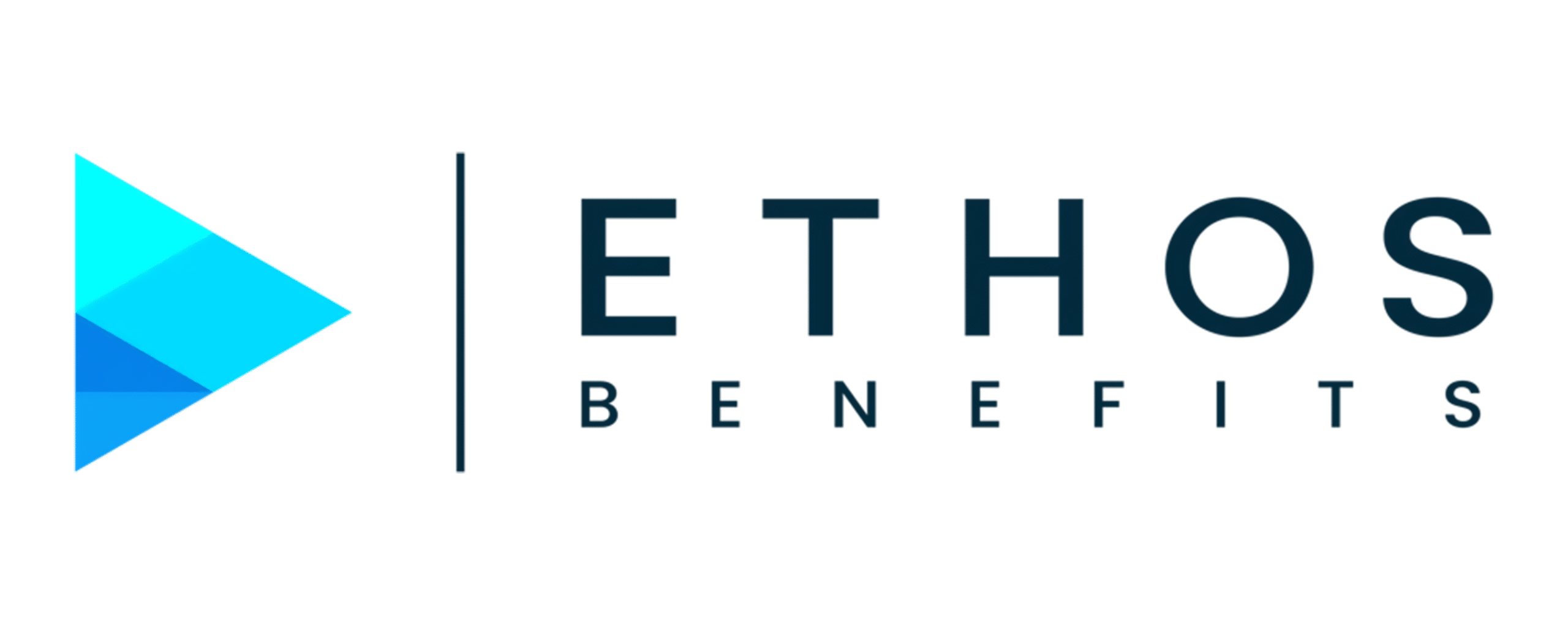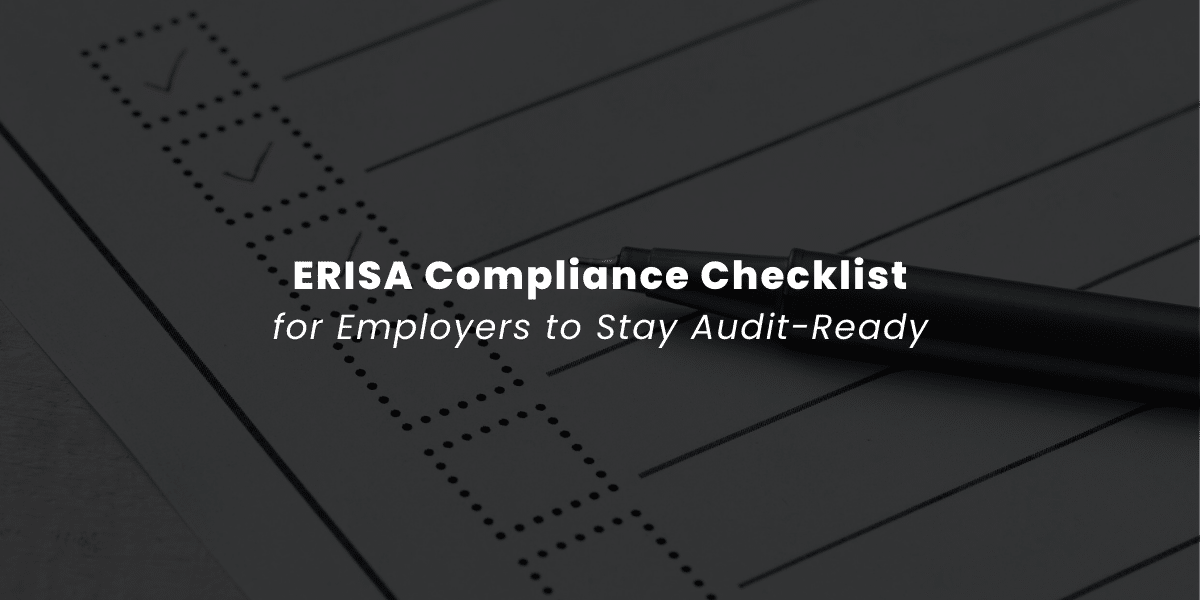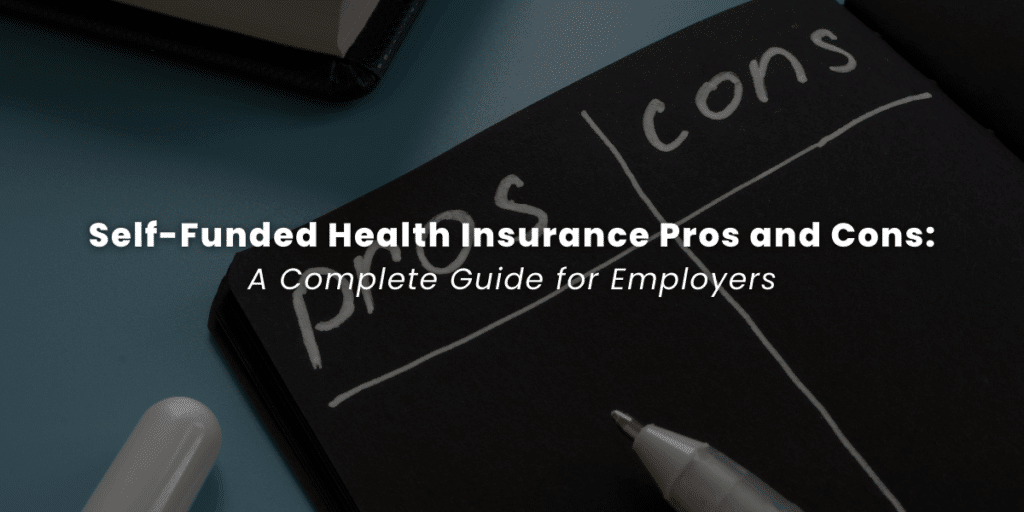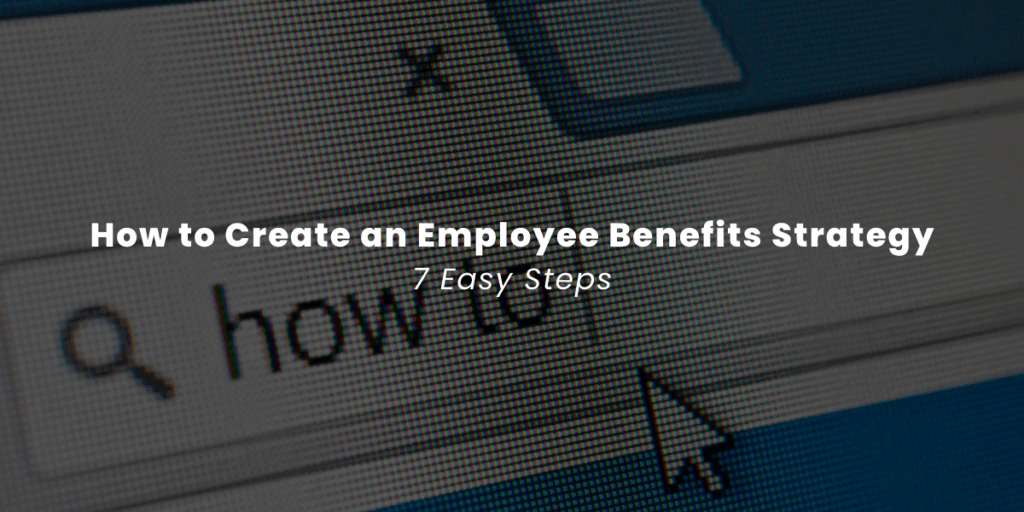As an employer offering retirement or health benefit plans, navigating the complex landscape of ERISA compliance can feel overwhelming. The Employee Retirement Income Security Act (ERISA) establishes critical standards that protect both your business and your employees—yet many organizations struggle to maintain full compliance, potentially exposing themselves to significant penalties and legal complications.
Whether you’re a small business owner just beginning to offer benefits or an established HR professional managing multiple plans, staying audit-ready isn’t just about avoiding penalties—it’s about fulfilling your fiduciary responsibility to your employees and protecting your company’s financial health.
In this comprehensive guide, we’ll walk through an actionable ERISA compliance checklist that helps plan sponsors and HR teams maintain proper documentation, meet filing deadlines, fulfill fiduciary obligations, and satisfy bonding requirements. By implementing these practices, you’ll not only minimize compliance risks but also strengthen the foundation of your employee benefits program.
TL;DR - ERISA Compliance Checklist
ERISA compliance requires meticulous attention to documentation, reporting, and fiduciary responsibilities. Key compliance areas include: maintaining comprehensive plan documents and summary plan descriptions (SPDs), filing Form 5500 annually, fulfilling fiduciary duties through prudent plan management, conducting regular plan audits, maintaining proper fidelity bonds, and establishing clear communication protocols with participants. Non-compliance can result in significant penalties—up to $1,100 per day for certain violations—making a systematic compliance approach essential for all plan sponsors. Regular self-audits using Department of Labor guidelines can help identify and address potential issues before they trigger regulatory action.
What Is ERISA and Why It Matters?
The Employee Retirement Income Security Act of 1974, commonly known as ERISA, represents one of the most significant pieces of federal legislation governing employee benefits in the United States. Enacted in response to widespread concerns about the mismanagement and failure of pension plans, ERISA established comprehensive standards designed to protect the interests of employee benefit plan participants and their beneficiaries.
The Foundation of Employee Benefit Protection
At its core, ERISA serves as a protective framework that ensures employees receive the benefits promised to them. The law applies to most voluntarily established retirement and health plans in private industry, covering an estimated 141 million American workers and more than $12 trillion in plan assets. This federal statute doesn’t require employers to establish benefit plans, but it sets mandatory rules for those who do.
ERISA’s jurisdiction extends to:
- Defined benefit pension plans
- 401(k) and other defined contribution plans
- Health insurance and medical plans
- Dental and vision plans
- Life and disability insurance
- Severance plans
- Scholarship funds
- Apprenticeship programs
Key Protections Under ERISA
ERISA’s framework creates several critical protections that directly impact both employers and employees:
Fiduciary Responsibilities: Perhaps most importantly, ERISA establishes strict fiduciary duties for plan administrators. These individuals must act solely in the interest of plan participants and beneficiaries, with the exclusive purpose of providing benefits and paying only reasonable plan expenses. This “prudent expert” standard represents one of the highest forms of fiduciary duty recognized by law.
Reporting and Disclosure: ERISA mandates transparency through comprehensive reporting to government agencies and disclosure to plan participants. This includes providing Summary Plan Descriptions (SPDs), Summary Annual Reports (SARs), and access to detailed plan information upon request.
Minimum Standards: The law establishes minimum standards for participation, vesting, benefit accrual, and funding. These standards ensure that employees can qualify for benefits within reasonable timeframes and that plans maintain adequate funding levels.
Enforcement Mechanisms: ERISA grants participants the right to sue for benefits and breaches of fiduciary duty, while also giving the Department of Labor extensive enforcement authority. This dual enforcement approach creates significant accountability for plan sponsors.
How ERISA Non-Compliance Affects Your Business
Non-compliance with ERISA regulations can have serious and far-reaching consequences for your business. Understanding these potential impacts is essential for prioritizing your compliance efforts and allocating appropriate resources to your benefits administration.
Financial Penalties and Enforcement Actions
Non-compliance with ERISA regulations can have serious and far-reaching consequences for your business. Understanding these potential impacts is essential for prioritizing your compliance efforts and allocating appropriate resources to your benefits administration.
ERISA Non-Compliance Penalties
| Type of Violation | Maximum Penalty | Details | Potential Financial Impact |
|---|---|---|---|
| Late or Missing Form 5500 | $1,100 per day |
|
Example: A plan that is 1 year late filing Form 5500 could face penalties of $401,500 ($1,100 × 365 days) |
| Missing or Late SPD/SMM Distribution | $110 per day per participant |
|
Example: A company with 500 employees that fails to provide SPDs for 30 days could face penalties of $1,650,000 ($110 × 500 participants × 30 days) |
| Prohibited Transactions | 15% of amount involved |
|
Example: A prohibited loan of $100,000 could result in initial penalties of $15,000, increasing to $100,000 if not corrected |
| Breach of Fiduciary Duty | 20% of recovery amount |
|
Example: A fiduciary breach resulting in $500,000 in plan losses could lead to $100,000 in penalties plus restoration of the full $500,000 |
Legal Vulnerability and Litigation Risk
Beyond regulatory penalties, ERISA non-compliance significantly increases your exposure to participant lawsuits:
Participant Civil Actions: ERISA grants participants the right to sue for benefits due, enforcement of rights under the plan, or breach of fiduciary duty. These lawsuits can be costly to defend, even if ultimately unsuccessful.
Class Action Exposure: ERISA claims are frequently pursued as class actions, dramatically increasing potential liability and legal costs. Recent years have seen a surge in ERISA class action litigation, particularly regarding excessive fees and imprudent investments.
Personal Liability: Plan fiduciaries can be held personally liable for losses resulting from breaches of their duties, creating significant risk for individual decision-makers within your organization.
Complete ERISA Compliance Checklist
Maintaining ERISA compliance requires systematic attention to documentation, reporting, disclosure, and fiduciary responsibilities. This comprehensive checklist organizes essential compliance tasks into key categories to help plan sponsors and HR teams stay audit-ready.
ERISA Compliance Checklist: Key Categories and Risk Levels
| Compliance Category | Key Requirements | Risk Level |
|---|---|---|
| Plan Documentation | Plan Document, SPD, SMM, SAR | High |
| Reporting & Filing | Form 5500, 8955-SSA, Fee Disclosures | Very High |
| Fiduciary Responsibilities | Loyalty, Prudence, Diversification, Plan Adherence | Very High |
| Bonding Requirements | ERISA Fidelity Bond (10% of funds handled) | Medium |
| Participant Communications | Required Notices, Claims Procedures | High |
| Operational Compliance | Eligibility, Contributions, Distributions, Testing | High |
This table outlines the key ERISA compliance categories, their essential requirements, and associated risk levels for non-compliance. Categories with “Very High” risk levels require immediate attention from plan sponsors.
Plan Documentation Requirements
The foundation of ERISA compliance lies in proper documentation. Every ERISA-covered plan must maintain these essential documents:
Plan Document: This formal written instrument establishes and governs your benefit plan, containing all provisions required by ERISA. Your plan document must include:
- Procedure for establishing and carrying out a funding policy
- Procedure for allocating operational and administrative responsibilities
- Provisions for plan amendment and termination procedures
- Specification of basis for payments to and from the plan
- Named fiduciary designation
Summary Plan Description (SPD): This plain-language explanation of the plan must be provided to participants and beneficiaries. SPDs must:
- Be written in a manner calculated to be understood by the average plan participant
- Be sufficiently comprehensive to inform participants of their rights and obligations
- Include specific content required by DOL regulations
- Be distributed within 90 days of enrollment for new participants
- Be redistributed every 5 years if changes are made, or every 10 years if no changes
Operational Compliance Calendar
ERISA Compliance Annual Timeline
Key Deadlines and Activities for Plan Sponsors
| First Quarter | Second Quarter | Third Quarter | Fourth Quarter |
|---|---|---|---|
January 31: Distribute W-2s and 1099-Rs
|
April 15: Process excess deferrals
|
July 31: Form 5500 due (calendar year plans)
|
December 31: Process RMDs, complete year-end compliance
|
Note: Timeline based on calendar year plans. Specific dates may vary based on plan year and extensions.
Common ERISA Compliance Pitfalls to Avoid
Even with the best intentions, plan sponsors frequently encounter compliance challenges that can lead to violations. Understanding these common pitfalls can help you proactively address potential problem areas before they trigger regulatory scrutiny or participant complaints.
Documentation Deficiencies
When to Consider Hiring ERISA Compliance Experts
While many organizations manage ERISA compliance internally, certain situations warrant bringing in specialized expertise. Understanding when to engage professional help can prevent costly compliance failures and provide valuable peace of mind.
Complexity Thresholds That Signal Expert Need
Plan Size and Complexity: As your benefit plans grow in size and complexity, the compliance burden increases exponentially:
- Plans with 100+ participants requiring annual audits
- Multiple benefit plans with different requirements
- Plans with unique features or complex designs
- Plans holding employer securities or alternative investments
Frequently Asked Questions (FAQs)
Do All Employers Need to File Form 5500?
Not all employers are required to file Form 5500. The filing requirement depends on the type of benefit plan and its size:
Plans Generally Required to File Form 5500:
- Retirement plans (401(k), profit sharing, defined benefit) with 1 or more participants
- Welfare benefit plans (health, dental, vision, disability, etc.) with 100 or more participants
- Multiple employer welfare arrangements (MEWAs), regardless of size
How Often Should I Update Plan Documents or Disclosures?
Plan documents and disclosures require regular updates to maintain compliance with changing regulations and plan operations:
Required Update Frequencies:
- Plan Documents: Must be amended for regulatory changes by deadlines specified in IRS or DOL guidance, which vary by type of change. Additionally, discretionary amendments should be adopted by the end of the plan year in which the change becomes effective.
- Summary Plan Descriptions (SPDs): Must be updated and redistributed:
- Every 5 years if the plan has been amended
- Every 10 years even if no changes have been made
- Within 210 days after the end of the plan year in which a material change was made (via a Summary of Material Modifications)
Conclusion
Navigating ERISA compliance doesn’t have to be overwhelming. By implementing a systematic approach to documentation, reporting, fiduciary responsibilities, and participant communications, employers can significantly reduce compliance risks while enhancing the value of their benefit programs.
The comprehensive checklist provided in this article offers a roadmap for maintaining compliance across all critical areas of ERISA regulation. By addressing each component methodically—from plan documentation and reporting requirements to fiduciary responsibilities and operational compliance—plan sponsors can develop robust compliance systems that withstand regulatory scrutiny.
Remember that ERISA compliance is not a one-time event but an ongoing process requiring regular attention and updates. As regulations evolve and your benefit plans change, your compliance approach must adapt accordingly. Establishing a regular review schedule, maintaining clear documentation of compliance activities, and seeking expert guidance when needed are essential practices for long-term compliance success.
References
- U.S. Department of Labor. “Compliance Assistance Guide – Appendix A: Self-Compliance Tools.” https://www.dol.gov/agencies/ebsa/employers-and-advisers/plan-administration-and-compliance/health-plans/hbec/checksheets
- Investopedia. “Is Your Business ERISA Compliant? Follow This Checklist.” https://www.investopedia.com/articles/personal-finance/081616/are-you-erisa-compliant-follow-checklist.asp
- BASIC. “Essential ERISA Compliance Checklist for Employers.” https://www.basiconline.com/blog/essential-erisa-compliance-checklist-for-employers/
- Employee Benefits Security Administration. “Fiduciary Responsibilities.” https://www.dol.gov/agencies/ebsa/employers-and-advisers/plan-administration-and-compliance/fiduciary-responsibilities
- Internal Revenue Service. “Retirement Plan Reporting and Disclosure Requirements.” https://www.irs.gov/retirement-plans/retirement-plan-reporting-and-disclosure-requirements
- Society for Human Resource Management. “ERISA Compliance Primer: What Plan Sponsors Need to Know.” https://www.shrm.org/resourcesandtools/hr-topics/benefits/pages/erisa-compliance-primer.aspx






